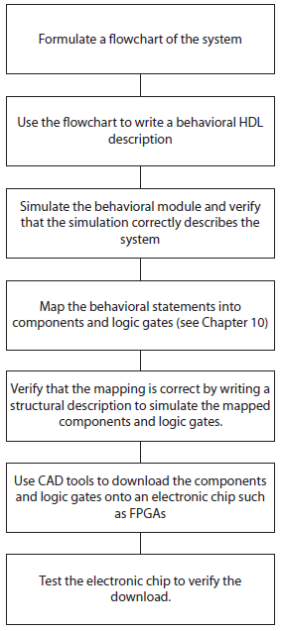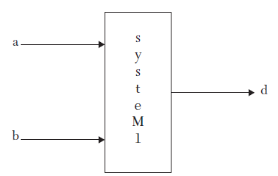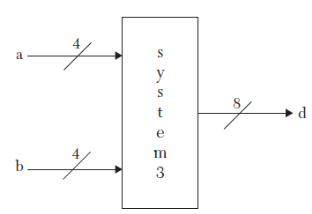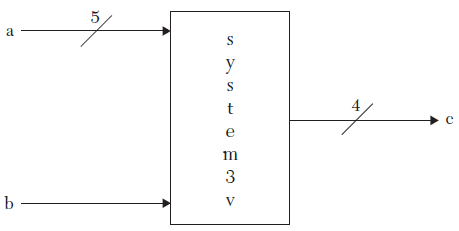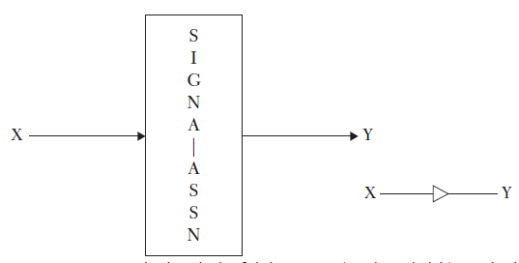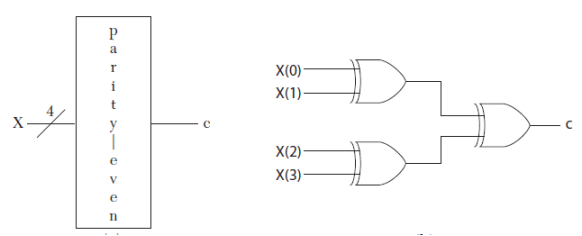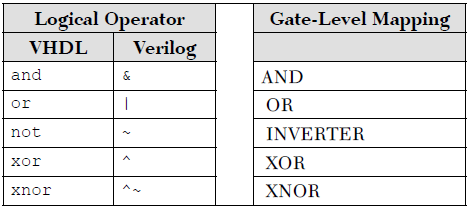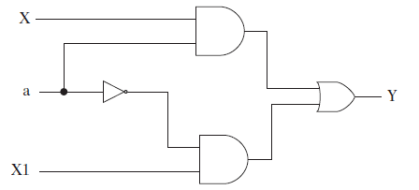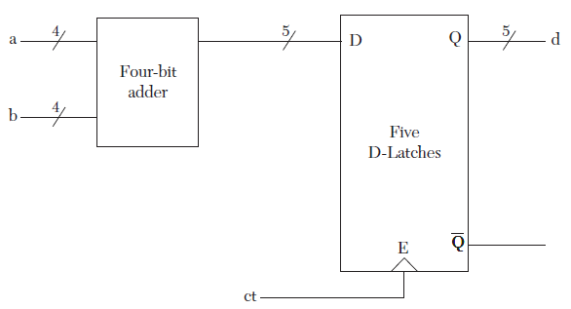|
Example -1 VHDL Code for System1 Entity entity system1 is port (a, b : in bit; d : out bit); end system1;
The synthesis information extracted from above example is summarized in the figure below; system1 has two input signals, each one bit, and one output signal of one bit. Each signal can take 0 (low) or 1 (high).
Example-2 - VHDL Code for System3 Entity
entity system3 is port (a, b : in std_logic_vector (3 downto 0); d : out std_logic_vector (7 downto 0)); end entity system3;
System3 has two four-bit input signals and one eight-bit output signal. The input signals can be binary or left open
|
Example-1- Verilog Code for Module System1v
module system1v (a, b, d); input a, b; output d; endmodule
Module system1v has two input signals, a and b, each of one bit, and one output signal d of one bit. All signals can take 0, 1, or high impedance.
Example-2 Verilog Code for Module System3v module system3v (a, b, c); parameter N = 4; parameter M = 3; input [N:0] a; output [M:0] c; input b; ......... endmodule
|
Example-1
Mapping VHDL Code for Signal-Assignment Statement Y <= X
library ieee; use ieee.std_logic_1164.all; entity SIGNA_ASSN is port (X : in bit; Y : out bit); end SIGNA_ASSN; architecture BEHAVIOR of SIGNA_ASSN is begin P1 : process (X) begin Y <= X; end process P1; end BEHAVIOR;
Example-2
Mapping Verilog Code for Signal-Assignment Statement Y = X
module SIGNA_ASSN (X, Y); input X; output Y; reg y; always @ (X) begin Y = X; end endmodule
|
The variable-assignment statement is a VHDL statement. Verilog does not distinguish between signal- and variable-assignment statements
Example-1
VHDL Variable-Assignment Statement
library ieee; use ieee.std_logic_1164.all; entity parity_even is port (x : in std_logic_vector (3 downto 0); C : out std_logic); end parity_even; architecture behav_prti of parity_even is begin P1 : process (x)
variable c1 : std_logic; begin c1 := (x(0) xor x(1)) xor (x(2) xor x(3)); C <= c1; end process P1;
end behav_prti;
|
) Mapping logical operators is relatively straightforward because finding the gate counterpart of a logical operator is very easy. For example, the mapping of logical operator and (VHDL) or & (Verilog) is an AND gate.
Example: Mapping Logical Operators: VHDL and Verilog
VHDL: Mapping Logical Operators
library IEEE; use IEEE.STD_LOGIC_1164.ALL; entity decod_var is port (a : in std_logic_vector (1 downto 0); D : out std_logic_vector (3 downto 0)); end decod_var; architecture Behavioral of decod_var is begin
dec : process (a) variable a0bar, a1bar : std_logic; begin a0bar := not a(0); a1bar := not a(1); D(0) <= not (a0bar and a1bar); D(1) <= not (a0bar and a(1)); D(2) <= not (a(0) and a1bar); D(3) <= not (a(0) and a(1));
end process dec;
end Behavioral;
Verilog: Mapping Logical Operators
module decod_var (a, D); input [1:0] a; output [3:0] D; reg a0bar, a1bar; reg [3:0] D; always @ (a) begin
a0bar = ~ a[0]; a1bar = ~ a[1];
D[0] = ~ (a0bar & a1bar); D[1] = ~ (a0bar & a[1]); D[2] = ~ (a[0] & a1bar); D[3] = ~ (a[0] & a[1]);
end endmodule
The statements a0bar := not a(0); -- VHDL a0bar = ~ a[0]; // Verilog
represent an inverter. The input to the inverter is the least significant bit of the input a. The statements
D[3] = ~ (a[0] & a[1]); -- VHDL D(3) <= not (a(0) and a(1)); // Verilog
represent a two-input NAND gate. The input is a, and the output is the most significant bit of D.
|
Example -1 VHDL IF-else Description
process (a, x) begin if (a = '1') then Y <= X; else Y <= '0'; end if; end process;
Verilog IF-else Description
always @ (a, X) begin if (a == 1'b1) Y = X; else Y = 1'b0; end
Its gate level synthesis will be AND gate
Example-2 VHDL Multiplexer IF-else Description
process (a, X, X1) begin if (a = '1') then Y <= X; else Y <= X1; end if; end process;
Verilog Multiplexer IF-else Description
always @ (a, X, X1) begin if (a == 1'b1) Y = X; else Y = X1; end
The above IF statement represents a 2x1 multiplexer.
|
Mapping the case statement is very similar to mapping the IF statement. The case statement is treated as a group of IF statements.
Example -1
module case_nostr (a, b, ct, d); input [3:0] a, b; input ct; output [4:0] d; reg [4:0] d; always @ (a, b, ct) begin
case (ct) 1’b0 : d = a + b; 1’b1 : d = a - b;
endcase end endmodule
Example-2
case Statement with Storage
module case_str (a, b, ct, d); input [3:0] a, b; input ct; output [4:0] d; reg [4:0] d; always @ (a, b, ct) begin
case (ct) 1’b0: d = a + b;
1’b1: ; /* This is a blank statement with
no operation (null in VHDL)*/
endcase
end endmodule
|
Loop in HDL description is an essential tool for behavioral modeling. It is, however, easier to code than it is to synthesize in the hardware domain. The problem is the repetition involved in the loop. Example-1 VHDL For-Loop Statement for i in 0 to 63 loop temp(i) := temp(i) + b(i); end loop; Verilog For-Loop Statement for i = 0; i <= 63; i = i + 1 begin temp[i] = temp[i] + b[i]; end
Each statement is synthesized as a one-bit adder temp(0) = temp(0) + b(0) temp(1) = temp (1) + b(1) temp(2) = temp(2) + b(2) …………………………… temp(63) = temp(63) + b(63) |
In the hardware domain, there is no logic for procedures or tasks; they are incorporated in the entity or the module that calls them.
Example-1
A Verilog Example of a Task
module example_task (a1, b1, d1); input a1, b1; output d1; reg d1;
always @ (a1, b1) begin xor_synth (d1, a1, b1); end
task xor_synth; output d; input a, b; begin d = a ^ b; end
endtask endmodule
Example -2
An Example of a Procedure
library IEEE; use IEEE.STD_LOGIC_1164.ALL;
entity Int_Bin is generic (N : integer := 3); port (X_bin : out std_logic_vector (N downto 0); Y_int : in integer; flag_even : out std_logic); end Int_Bin;
architecture convert of Int_Bin is procedure itb (bin : out std_logic_vector; signal flag : out std_logic; N : in integer; int : inout integer) is begin
if (int MOD 2 = 0) then flag <= ‘1’;
else flag <= ‘0’;
end if;
for i in 0 to N loop if (int MOD 2 = 1) then bin (i) := ‘1’; else bin (i) := ‘0’; end if; int := int / 2; end loop;
end itb; begin process (Y_int) variable tem : std_logic_vector (N downto 0); variable tem_int : integer; begin tem_int := Y_int; itb (tem, flag_even, N, tem_int); X_bin <= tem; end process;
end convert; |
Example- Verilog Example of a Function
module Func_synth (a1, b1, d1); input a1, b1; output d1; reg d1;
always @ (a1, b1) begin d1 = andopr (a1, b1); end
function andopr; input a, b; begin andopr = a ^ b; end
endfunction endmodule
In the hardware domain, there is no distinction between the main module and a function; we look to see what the function is performing and then incorporate this information in the entity or module where the function is being called. the function andopr is performing an AND logical operation on two operands.
|
